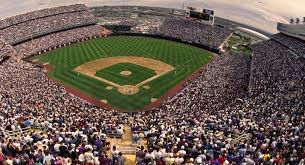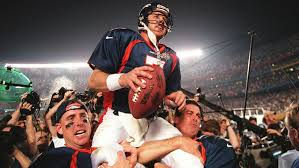Mile High Stadium
- David Hegler

- Aug 11
- 6 min read

For years, Denver's Mile High Stadium was one of the toughest places in all of sports for an away team to earn a win. With the altitude literally a mile above sea level, many a foe succumbed to the fierce climate as well as the constant clang of 80,000 pairs of feet against the steel bleachers. Of course, things only escalated after the Broncos traded for John Elway after the 1983 NFL Draft.
Bears Stadium
The site that would one day hold so many memorable moments in Denver's illustrious history began as a simple landfill. In 1948, an 18,000 seat ballpark was built for the Western League's Denver Bears. Luther "Bud" Phillips hit the first home run in the stadium's history when it first opened on April 14, 1948. Over their first two years of existence, the Bears led the league in attendance and even outdrew the major league's St. Louis Browns in 1949. To top it off, the Bears won the Western League title in 1952, further establishing themselves as the new standard in their classification.
By 1955, the Bears had moved on to the American Association/Pacific Coast League where they would remain until 1992. They immediately established themselves as a contender in the AA by winning the championship in 1957. It would be 14 long years until they won another.
By 1960, Bears Stadium got a major upgrade when the AFL was formed and set up shop in Denver. Expansion increased capacity to more than 34,000. Lionel Taylor's two touchdown receptions from Frank Tripucka sparked a 21-0 flurry in the second quarter powered the Broncos first game at Bears Stadium on October 2 as they coasted down the stretch to an easy 31-14 win over the Oakland Raiders.
The rest of the Broncos inaugural season was not so smooth as they finished the year 4-9-1. It was a harbinger of things to come for the young football team over its first decade and a half. Other than a 7-7 season in 1962, the Broncos finished every year until 1973 as losers, with many of those years spent at the bottom of the cellar.
Making matters worse was their hideous uniforms featuring an appalling mustard yellow jersey with brown numbers and brown pants with yellow stripes all topped off with an uninspiring brown helmet. The whole ensemble reeked of a losing mentality that could only spell trouble for Bears Stadium's future attendance so in 1962, Broncos management threw all of their old jerseys into a bonfire and brought out brightly colored orange jerseys with blue helmets. Although it was not the greatest, Broncos fans grew to love the new color scheme. Like much of the decade, change was constantly in the air in Denver and by 1968, the Broncos home got a new name.
Mile High Stadium

Just before the Broncos took the field for the 1968 season, their home of eight years was renamed "Mile High Stadium", a fitting tribute to its location 5,280 feet above sea level. In the second game that year, rookie Marlin Briscoe completed four of his 11 passes for 37 yards in a 10-7 win over the Cincinnati Bengals at the newly minted Mile High Stadium, becoming the first African American quarterback to start a game in the AFL/NFL in the modern age.
Being a rookie, coach Lou Saban was all too happy to relegate him back to the bench when his regular starter returned. However, Briscoe was thrust back into the starting roll when the Broncos ran out of options later in the year, throwing four touchdowns in a thrilling 34-32 win over the powerful Buffalo Bills before losing the last three games of the season. Although he never did get a fair shake at quarterback after that memorable season, Briscoe had made history.
Expansion of Mile High Stadium in 1975 brought its capacity to over 75,00. With a nine-million pound east stands that could be moved back and forth on a track of water for baseball games, Denver's athletic oasis was well prepared for the best years of its existence. Mile High Stadium's massive expansion could not have come at a better time as the Denver Bears had returned to their winning ways, taking advantage of the thin air as well as the 423 foot center field and 333 foot left field, winning American Association titles in 1971, 1976, 1977, 1981 and 1983.
In 1977, the Broncos beat the odds by capturing their first divisional title and beating the defending champion Oakland Raiders in Denver to stamp their ticket to the Super Bowl. Although they lost to the Dallas Cowboys, the city of Denver had come alive for their beloved team and the applause never died.
In 1983, the Broncos traded for the top pick in the draft, John Elway and quickly became contenders for the next decade and a half. Elway made a career out of staging late game comebacks and completing eye-popping passes to rip the heart out of the opponent. In 1986, luxury suites were built atop the facility to bring Mile High Stadium's final capacity to over 80,000.

This addition was just in time for John Elway's coming of age. That year Elway began an incredible stretch where he led the Broncos to three Super Bowls in four years, losing each in memorable fashion. However their season ultimately ended, John Elway made sure that people remembered his name and his teammates returned the favor by playing their hearts out in one of the NFL's toughest venues.
In the 1987 AFC Championship Game, cornerback Jeremiah Castille stripped the ball from Browns running back Earnest Byner who was just five yards away from tying the game in the closing minute, stamping the Broncos ticket to the Super Bowl where the Broncos were again pummeled.
In 1993, Major League Baseball expanded to Denver and the Rockies were born. Largely due to the vastness of the venue, the Rockies drew a record 4,483,350 to Mile High Stadium in their inaugural season. To this day, that record remains untouched. The following year, the Rockies drew 3.2 million before the strike shut everything down. The Rockies moved to Coors Field in 1995, ceding residency of Mile High Stadium to the Broncos.
Meanwhile, the Broncos had been quietly busy building perhaps their greatest teams in the John Elway era. In 1996, it appeared that the Broncos had built a team that could finally break through the Super Bowl-sized barrier. Behind a stout offensive line danced running back Terrell Davis, dashing through holes designed by coach Mike Shanahan.
With Elway enjoying a cadre of receivers led by tight end Shannon Sharpe, Ed McCaffrey and Rod Smith, the Broncos tore their way through the 1996 season, earning the top seed in the playoffs. All was well until the Jacksonville Jaguars came to town, the second-year franchise stunning the Broncos in the Divisional Round. The 30-27 shocker was just the second time that the Broncos had ever lost at Mile High Stadium in the playoffs.
Wearing new navy blue jerseys, the Broncos trudged through the following season, knowing all too well that their peerless leader's days on the gridiron were numbered. They pounded the Jaguars in the Wild Card Round at Mile High Stadium with Terrell Davis rumbling for 184 yards on 31 carries in the 42-17 triumph. The Broncos won their next two playoff games on the road before defeating the Green Bay Packers in the Super Bowl.

Emboldened by their recent triumph, the Broncos came out firing on all cylinders in 1998, winning 14 games and steamrolling their way to the AFC title game. No one believed that their opponents, the New York Jets, were as stout as they were. But these Jets were coached by two of the better defensive minds in the game's long history: Bill Parcells and Bill Belichick.
Early on, the Broncos were caught flat-footed as they were paying more attention to the NFC Championship Game rather than their own and before they knew it, they were down 10-0. That's when John Elway delivered the final magical moment at Mile High Stadium in his illustrious career, leading his team to a convincing 23-10 victory. Two weeks later, the Broncos were Super Bowl champions again.
The Final Moment
By the turn of the millennium, the Broncos had begun building a new stadium right next to their old home. With Invesco Field scheduled to open by the 2001 season, the Broncos entered the regular season finale against the San Francisco 49ers determined to win their final game at their beloved home.
With the 49ers having suffered through another difficult year, the game itself was not much of a contest as the Broncos pulled away to win 38-9. However, the game was littered with little reminders of the stadium's glory days. When Jason Elam nailed a 20-yard field goal to open up the scoring in the second quarter, many in the crowd remembered the time when he tied the NFL record with a 63-yarder just two years earlier. When Ed McCaffrey caught a 35-yard touchdown from Gus Frerotte, it was a glimpse at the last of John Elway's legendary career.
When the final horn blared, Mile High Stadium officially closed for business on December 23, 2000. After the Broncos lost to the Ravens in Baltimore in their playoff opener, they moved across the street to their new home, forever remembering the gleam of their old one. Today in Parking Lot J of the Bronco's current home stands the Mile High Monument, a tribute to the Broncos original home on the very spot where so many memories were made.

References
https://www.stadiumsofprofootball.com/stadiums/mile-high-stadium/
https://www.ballparksofbaseball.com/ballparks/mile-high-stadium/
https://www.pro-football-reference.com/boxscores/196010020den.htm
https://www.pro-football-reference.com/boxscores/200012230den.htm
https://www.pro-football-reference.com/boxscores/199810250den.htm
https://www.pro-football-reference.com/teams/den/playoffs.htm
https://www.pro-football-reference.com/boxscores/199901170den.htm



Comments